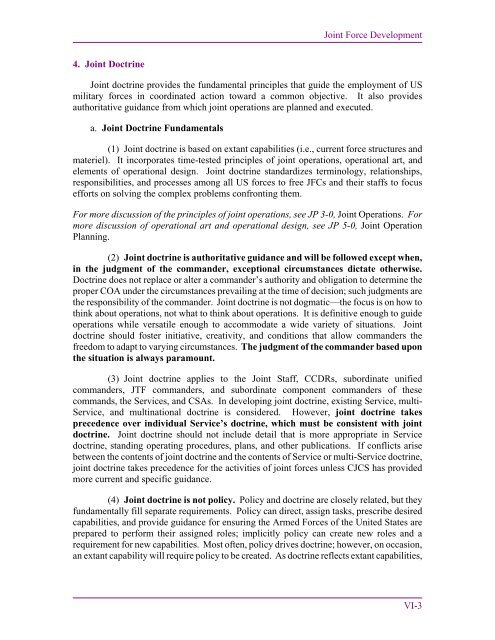JP 1, Doctrine for the Armed Forces of the United States - Defense ...
JP 1, Doctrine for the Armed Forces of the United States - Defense ...
JP 1, Doctrine for the Armed Forces of the United States - Defense ...
You also want an ePaper? Increase the reach of your titles
YUMPU automatically turns print PDFs into web optimized ePapers that Google loves.
Joint Force Development<br />
4. Joint <strong>Doctrine</strong><br />
Joint doctrine provides <strong>the</strong> fundamental principles that guide <strong>the</strong> employment <strong>of</strong> US<br />
military <strong>for</strong>ces in coordinated action toward a common objective. It also provides<br />
authoritative guidance from which joint operations are planned and executed.<br />
a. Joint <strong>Doctrine</strong> Fundamentals<br />
(1) Joint doctrine is based on extant capabilities (i.e., current <strong>for</strong>ce structures and<br />
materiel). It incorporates time-tested principles <strong>of</strong> joint operations, operational art, and<br />
elements <strong>of</strong> operational design. Joint doctrine standardizes terminology, relationships,<br />
responsibilities, and processes among all US <strong>for</strong>ces to free JFCs and <strong>the</strong>ir staffs to focus<br />
ef<strong>for</strong>ts on solving <strong>the</strong> complex problems confronting <strong>the</strong>m.<br />
For more discussion <strong>of</strong> <strong>the</strong> principles <strong>of</strong> joint operations, see <strong>JP</strong> 3-0, Joint Operations. For<br />
more discussion <strong>of</strong> operational art and operational design, see <strong>JP</strong> 5-0, Joint Operation<br />
Planning.<br />
(2) Joint doctrine is authoritative guidance and will be followed except when,<br />
in <strong>the</strong> judgment <strong>of</strong> <strong>the</strong> commander, exceptional circumstances dictate o<strong>the</strong>rwise.<br />
<strong>Doctrine</strong> does not replace or alter a commander’s authority and obligation to determine <strong>the</strong><br />
proper COA under <strong>the</strong> circumstances prevailing at <strong>the</strong> time <strong>of</strong> decision; such judgments are<br />
<strong>the</strong> responsibility <strong>of</strong> <strong>the</strong> commander. Joint doctrine is not dogmatic—<strong>the</strong> focus is on how to<br />
think about operations, not what to think about operations. It is definitive enough to guide<br />
operations while versatile enough to accommodate a wide variety <strong>of</strong> situations. Joint<br />
doctrine should foster initiative, creativity, and conditions that allow commanders <strong>the</strong><br />
freedom to adapt to varying circumstances. The judgment <strong>of</strong> <strong>the</strong> commander based upon<br />
<strong>the</strong> situation is always paramount.<br />
(3) Joint doctrine applies to <strong>the</strong> Joint Staff, CCDRs, subordinate unified<br />
commanders, JTF commanders, and subordinate component commanders <strong>of</strong> <strong>the</strong>se<br />
commands, <strong>the</strong> Services, and CSAs. In developing joint doctrine, existing Service, multi-<br />
Service, and multinational doctrine is considered. However, joint doctrine takes<br />
precedence over individual Service’s doctrine, which must be consistent with joint<br />
doctrine. Joint doctrine should not include detail that is more appropriate in Service<br />
doctrine, standing operating procedures, plans, and o<strong>the</strong>r publications. If conflicts arise<br />
between <strong>the</strong> contents <strong>of</strong> joint doctrine and <strong>the</strong> contents <strong>of</strong> Service or multi-Service doctrine,<br />
joint doctrine takes precedence <strong>for</strong> <strong>the</strong> activities <strong>of</strong> joint <strong>for</strong>ces unless CJCS has provided<br />
more current and specific guidance.<br />
(4) Joint doctrine is not policy. Policy and doctrine are closely related, but <strong>the</strong>y<br />
fundamentally fill separate requirements. Policy can direct, assign tasks, prescribe desired<br />
capabilities, and provide guidance <strong>for</strong> ensuring <strong>the</strong> <strong>Armed</strong> <strong>Forces</strong> <strong>of</strong> <strong>the</strong> <strong>United</strong> <strong>States</strong> are<br />
prepared to per<strong>for</strong>m <strong>the</strong>ir assigned roles; implicitly policy can create new roles and a<br />
requirement <strong>for</strong> new capabilities. Most <strong>of</strong>ten, policy drives doctrine; however, on occasion,<br />
an extant capability will require policy to be created. As doctrine reflects extant capabilities,<br />
VI-3

















